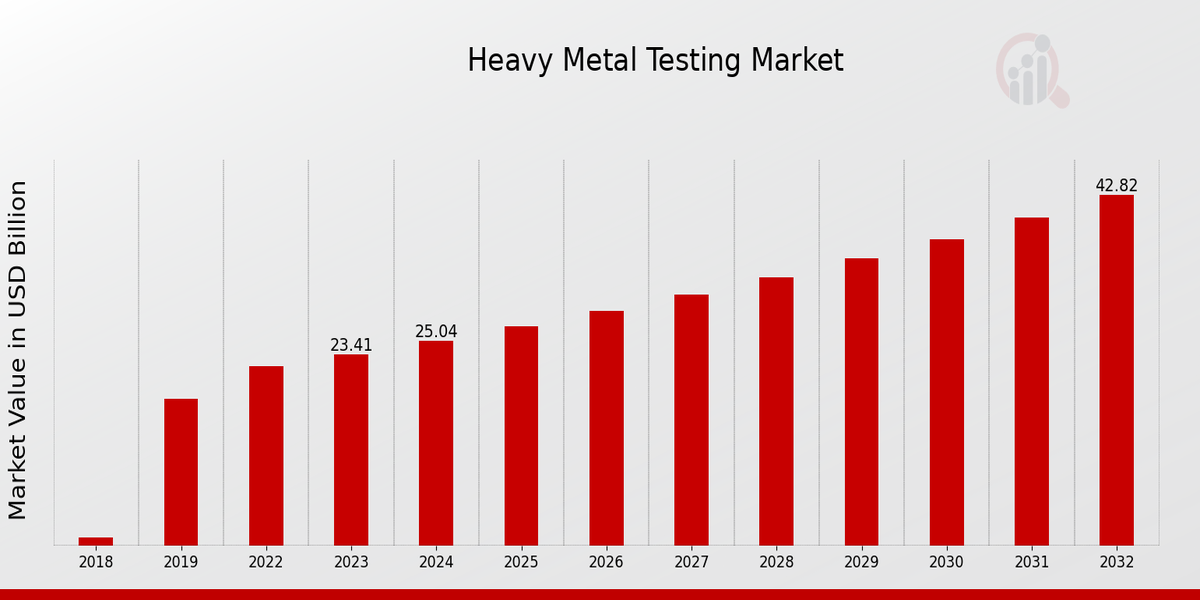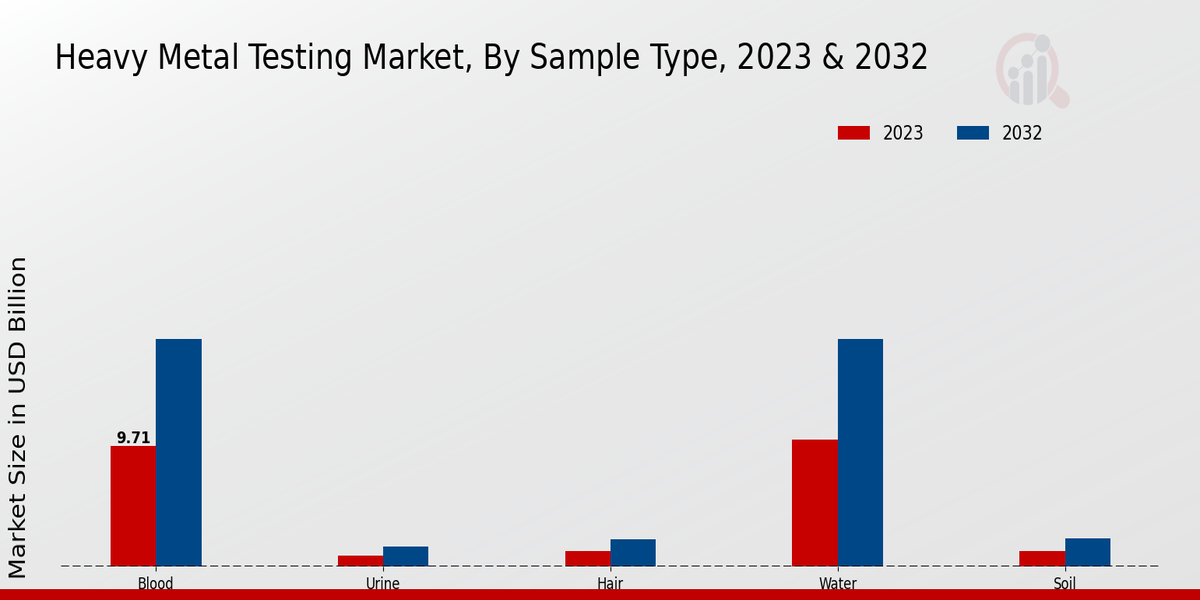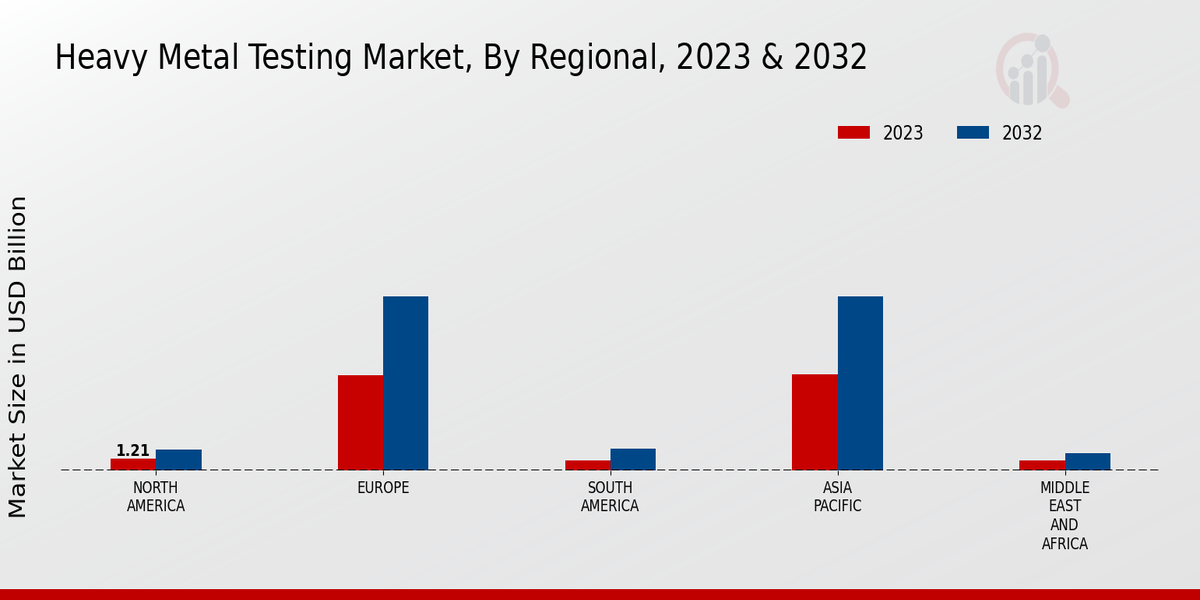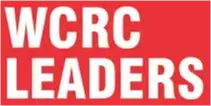Global Heavy Metal Testing Market Overview
As per MRFR analysis, the Heavy Metal Testing Market Size was estimated at 26.77 (USD Billion) in 2024. The Heavy Metal Testing Market Industry is expected to grow from 28.63 (USD Billion) in 2025 to 52.38 (USD Billion) till 2034, at a CAGR (growth rate) is expected to be around 6.94% during the forecast period (2025 - 2034).
Key Heavy Metal Testing Market Trends Highlighted
Heavy metal contamination in food and environmental samples has raised concerns about its adverse effects on human health. The Heavy Metal Testing Market has been witnessing a surge in demand due to increasing awareness about the harmful effects of heavy metals. Strict government regulations and environmental concerns are driving the market growth.
The rising adoption of advanced analytical techniques and the growing need for quality control in the food and beverage industries are further contributing to the market's expansion. Additionally, advancements in sample preparation techniques and the development of portable heavy metal testing devices are creating new opportunities in the market. The integration of artificial intelligence and machine learning into heavy metal testing is a recent trend, enhancing accuracy and efficiency in detection.

Source: Primary Research, Secondary Research, MRFR Database and Analyst Review
Heavy Metal Testing Market Drivers
-
Demand for Heavy Metal Testing in Environmental Monitoring
Heavy metals have caused an increasing concern in relation to environmental pollution worldwide. Heavy metals are built up in the environment mainly through industrial activities such as mining, smelting and manufacturing, leading to serious risks to human health and ecosystems. There is consequently a growing need for heavy metal testing services which monitor and assess the levels of these elements in the environment. Testing for heavy metals is essential for safeguarding air, water, and soil.
These matrices can be tested for their content of heavy metals, thus enabling the necessary authorities to put into place relevant measures aimed at reducing contamination and safeguarding public well-being. Therefore, it is important that there are regular checks on how well environmental clean-up exercises are going on, which will thus help get rid of elevated levels of these substances.
Growing awareness about the negative impacts of heavy metal pollution on humans and the environment has contributed to high demands for heavy metal testing services, especially in environmental monitoring. Governments globally are putting strict controls on emissions and pollution caused by heavy metals. As a result, there has been increased demand for reliable and credible providers offering such tests so that they meet legal requirements while protecting nature’s assets along with the public.
Moreover, the growth of green technologies plus sustainable practices being witnessed across various industries is driving massive requirements for analyzing heavy metals. Companies’ main objective nowadays is to minimize any damage they cause to nature while trying to prove that they embrace a sustainability approach. By determining whether their own activities have any effects on this type of contamination, organizations can enjoy a bigger market share besides enhancing their brand identity.
This, in turn, is driving the growth of the Heavy Metal Testing Market in environmental monitoring.
Advancements in Analytical Techniques
Technological advancements in analytical techniques have significantly contributed to the growth of the Heavy Metal Testing Market. The development of sophisticated analytical instruments and methodologies has enhanced the accuracy, sensitivity, and efficiency of heavy metal testing. Inductively coupled plasma mass spectrometry (ICP-MS) and atomic absorption spectrometry (AAS) are widely used analytical techniques for heavy metal analysis.
These techniques provide accurate and reliable quantification of heavy metals in various matrices, including water, soil, air, and biological samples. The continuous development and refinement of these techniques have improved their sensitivity and reduced detection limits, enabling the detection of trace levels of heavy metals. Advancements in sample preparation techniques have also contributed to the improved accuracy and precision of heavy metal testing.
Innovations in extraction and digestion methods have enhanced the efficiency of extracting heavy metals from complex matrices, reducing the risk of contamination and ensuring representative sample analysis. These advancements have made heavy metal testing more accessible and cost-effective, further driving the growth of the Heavy Metal Testing Market Industry.
Rising Health Concerns and Regulatory Compliance
Growing health concerns associated with heavy metal exposure have fueled the demand for heavy metal testing services. Heavy metals can accumulate in the body over time and pose severe health risks, including neurological damage, kidney and liver dysfunction, and developmental disorders. The increasing awareness about the adverse effects of heavy metals on human health has led to a greater emphasis on monitoring and controlling heavy metal exposure.
Regulatory bodies worldwide are implementing stringent regulations to limit heavy metal emissions and contamination in various sectors, including food, pharmaceuticals, and manufacturing. These regulations require regular testing and monitoring of heavy metals to ensure compliance and protect public health and the environment. The need to comply with these regulations has driven the demand for reliable and accurate heavy metal testing services.
Heavy Metal Testing Market Segment Insights
Heavy Metal Testing Market Sample Type Insights
The Sample Type segment of the Heavy Metal Testing Market is categorized into blood, urine, hair, water, and soil. Each sample type offers unique advantages and is utilized in specific scenarios. Blood samples provide a comprehensive analysis of heavy metal levels in the body. They are often used for diagnostic purposes, monitoring occupational exposure, and assessing the effectiveness of chelation therapy. Urine samples are less invasive and are commonly used for routine screening and monitoring purposes.
Hair samples provide an indication of heavy metal exposure over a longer period, making them suitable for retrospective analysis. Water and soil samples are used to evaluate environmental contamination. Water samples are tested to ensure the safety of drinking water, while soil samples are analyzed to assess the impact of industrial activities and agricultural practices on soil quality. The Heavy Metal Testing Market revenue for the Sample Type segment is expected to grow significantly due to increasing awareness about the adverse effects of heavy metal exposure, stringent environmental regulations, and advancements in analytical techniques.

Source: Primary Research, Secondary Research, MRFR Database and Analyst Review
Heavy Metal Testing Market Technology Insights
The Heavy Metal Testing Market is segmented based on Technology into Atomic Absorption Spectroscopy (AAS), Inductively Coupled Plasma Mass Spectrometry (ICP-MS), and X-ray Fluorescence (XRF). Among these, the AAS segment held the largest market share in 2023 and is expected to maintain its dominance throughout the forecast period.
This is attributed to its high sensitivity, accuracy, and cost-effectiveness. The ICP-MS segment is projected to witness significant growth over the coming years due to its ability to detect a wide range of metals at low concentrations. The XRF segment is also expected to grow steadily, driven by its non-destructive nature and ability to analyze solid samples.
Heavy Metal Testing Market Application Insights
Environmental Monitoring segment held the largest market share of 32.4% in 2023 and is expected to continue its dominance throughout the period. This growth is attributed to the increasing awareness about the harmful effects of heavy metals on the environment and stringent government regulations for monitoring heavy metal contamination in air, water, and soil. Moreover, the growing demand for environmental testing services from various industries, such as manufacturing, mining, and construction, is further driving the growth of the segment. Food Safety segment accounted for a significant market share of 27.5% in 2023.
This is due to the rising concerns over food safety and the need to ensure the quality and safety of food products. Heavy metal testing is essential to detect and quantify the presence of heavy metals in food, which can pose serious health risks to consumers. The increasing demand for food safety testing services from food manufacturers, retailers, and regulatory agencies is contributing to the growth of this segment. Occupational Health segment is expected to witness a steady growth rate during the forecast period.
The growing awareness about the occupational hazards associated with exposure to heavy metals is driving the demand for occupational health testing services. Heavy metal testing is crucial for assessing the exposure levels of workers in various industries, such as mining, manufacturing, and construction, and for implementing appropriate measures to protect their health.
Pharmaceutical Analysis segment held a market share of 18.2% in 2023 and is anticipated to grow at a significant rate during the forecast period. Heavy metal testing plays a vital role in pharmaceutical analysis, ensuring the safety and efficacy of pharmaceutical products. The increasing demand for heavy metal testing services from pharmaceutical companies and research institutions is fueling the growth of this segment.
Heavy Metal Testing Market Regional Insights
The Heavy Metal Testing Market is segmented into North America, Europe, APAC, South America, and MEA. North America and Europe are the dominant markets for heavy metal testing, accounting for over 60% of the global market share. The growth in these regions is driven by stringent regulations regarding heavy metal contamination in food and beverages.
APAC is expected to witness the highest growth rate over the forecast period, owing to the increasing demand for food safety testing in developing countries such as China and India. South America and MEA are expected to grow at a moderate pace, driven by the rising awareness about heavy metal contamination and the adoption of food safety standards.

Source: Primary Research, Secondary Research, MRFR Database and Analyst Review
Heavy Metal Testing Market Key Players And Competitive Insights
Major players in the Heavy Metal Testing Market industry are constantly striving to improve their technologies and expand their product offerings. Leading Heavy Metal Testing Market players are investing heavily in research and development to stay ahead of the competition. The Heavy Metal Testing Market is highly competitive, with a number of established players and several new entrants. The market is expected to witness significant growth in the coming years, owing to increasing awareness about the harmful effects of heavy metals and growing demand for food safety testing.
One of the leading players in the Heavy Metal Testing Market is Eurofins Scientific, which offers a wide range of testing services for heavy metals in various matrices, including food, water, soil, and air. Another major player is SGS, which provides a comprehensive suite of analytical services for heavy metals, including testing for compliance with regulatory limits and product specifications. Intertek is another prominent player in the Heavy Metal Testing Market, offering a range of testing services for heavy metals in food, environmental, and industrial samples.
Another leading player in the Heavy Metal Testing Market is ALS Limited, which provides a comprehensive range of testing services for heavy metals in various matrices, including food, water, soil, and air. Bureau Veritas is another major player in the Heavy Metal Testing Market, offering a wide range of testing services for heavy metals in food, environmental, and industrial samples. These leading players are constantly investing in new technologies and expanding their product offerings to meet the growing demand for heavy metal testing services. The Heavy Metal Testing Market is expected to witness significant growth in the coming years, driven by increasing awareness about the harmful effects of heavy metals and a growing demand for food safety testing.
Key Companies in the Heavy Metal Testing Market Include
- Control Union
- Neogen Corporation
- Bureau Veritas
- FoodChain ID
- UL LLC
- SGS S.A.
- ALS Limited
- QSI
- Exponent
- AsureQuality
- Romer Labs
- Intertek Group plc
- NSF International
- Eurofins Scientific
- Mérieux NutriSciences
Heavy Metal Testing Market Industry Developments
The Heavy Metal Testing Market is projected to reach USD 42.8 billion by 2032, exhibiting a CAGR of 6.94% from 2025 to 2034. Rising concerns over the adverse effects of heavy metals on human health and the environment, coupled with stringent government regulations, are driving market growth.
Technological advancements, such as the development of portable and handheld devices, are further expanding market opportunities. Key industry developments include the acquisition of EnviroLab by Eurofins Scientific in 2023, strengthening its position in the environmental testing market. Additionally, the launch of new products, such as the "Metalscan" portable heavy metal analyzer by Bruker, is expected to cater to the growing demand for on-site testing.
Heavy Metal Testing Market Segmentation Insights
-
Heavy Metal Testing Market Sample Type Outlook
- Blood
- Urine
- Hair
- Water
- Soil
-
Heavy Metal Testing Market Technology Outlook
- Atomic Absorption Spectroscopy (AAS)
- Inductively Coupled Plasma Mass Spectrometry (ICP-MS)
- X-ray Fluorescence (XRF)
-
Heavy Metal Testing Market Application Outlook
- Environmental Monitoring
- Food Safety
- Occupational Health
- Pharmaceutical Analysis
-
Heavy Metal Testing Market Regional Outlook
- North America
- Europe
- South America
- Asia Pacific
- Middle East and Africa
| Report Attribute/Metric |
Details |
|
Market Size 2024
|
26.77 (USD Billion)
|
|
Market Size 2025
|
28.63 (USD Billion)
|
|
Market Size 2034
|
52.38 (USD Billion)
|
|
Compound Annual Growth Rate (CAGR)
|
6.94% (2025 - 2034)
|
|
Report Coverage
|
Revenue Forecast, Competitive Landscape, Growth Factors, and Trends
|
|
Base Year
|
2024
|
|
Market Forecast Period
|
2025 - 2034
|
|
Historical Data
|
2019 - 2023
|
| Market Forecast Units |
USD Billion |
| Key Companies Profiled |
Control Union, Neogen Corporation, Bureau Veritas, FoodChain ID, UL LLC, SGS S.A., ALS Limited, QSI, Exponent, AsureQuality, Romer Labs, Intertek Group plc, NSF International, Eurofins Scientific, Mérieux NutriSciences |
| Segments Covered |
Sample Type, Technology, Application, Regional |
| Key Market Opportunities |
1 Rising demand for food safety testing2 Growing environmental concerns and regulations3 Technological advancements in testing methods4 Increasing global population and industrialization5 Expansion of the pharmaceutical and healthcare industries |
| Key Market Dynamics |
Increased environmental regulations Growing awareness of health impacts Advancements in analytical techniques Expansion of food and beverage industry Rising demand for heavy metal testing in pharmaceuticals |
| Countries Covered |
North America, Europe, APAC, South America, MEA |
Frequently Asked Questions (FAQ) :
The Global Heavy Metal Testing Market is expected to reach a valuation of USD 52.38 billion by 2034, exhibiting a CAGR of 6.94% from 2025 to 2034.
North America and Europe are the dominant regions in the Heavy Metal Testing Market, owing to stringent regulations and growing awareness about the adverse effects of heavy metals. Asia-Pacific is anticipated to witness substantial growth due to rapid industrialization and urbanization.
Environmental monitoring, food safety testing, and occupational health testing are the major applications driving the growth of the Heavy Metal Testing Market. Growing concerns about environmental pollution and food safety are fueling the demand for heavy metal testing services.
Key players in the Heavy Metal Testing Market include SGS, Eurofins Scientific, Intertek Group, Bureau Veritas, and TV SD. These companies offer a comprehensive range of heavy metal testing services catering to various industries.
The challenges faced by the Heavy Metal Testing Market include the high cost of testing equipment, stringent regulatory requirements, and the need for skilled professionals. Additionally, the lack of harmonized regulations across different regions can hinder market growth.
Growing environmental concerns, increasing demand for food safety testing, and advancements in analytical techniques are expected to create growth opportunities for the Heavy Metal Testing Market. The rising awareness about the adverse effects of heavy metals is also driving the demand for testing services.
The latest trends in the Heavy Metal Testing Market include the adoption of portable and handheld devices, the use of biosensors for rapid and cost-effective testing, and the integration of artificial intelligence (AI) for data analysis and interpretation.
The regulatory landscape of the Heavy Metal Testing Market varies across different regions. Stringent regulations in North America and Europe have driven the growth of the market, while emerging economies are in the process of developing and implementing comprehensive regulations.
Rapid industrialization, urbanization, and increasing awareness about environmental pollution are driving the growth of the Heavy Metal Testing Market in developing countries. The demand for testing services is rising due to concerns about food safety, water quality, and soil contamination.
The future outlook for the Heavy Metal Testing Market is positive, with the market expected to continue growing at a steady pace. Increasing environmental concerns, technological advancements, and growing demand from various industries are expected to contribute to the sustained growth of the market.





























